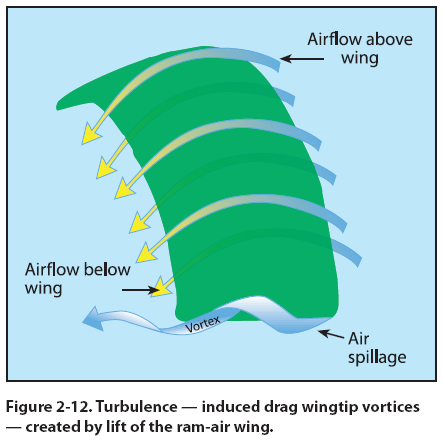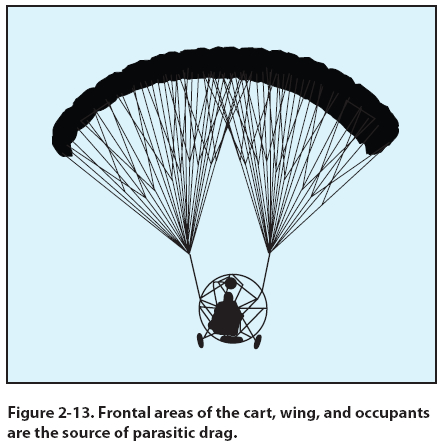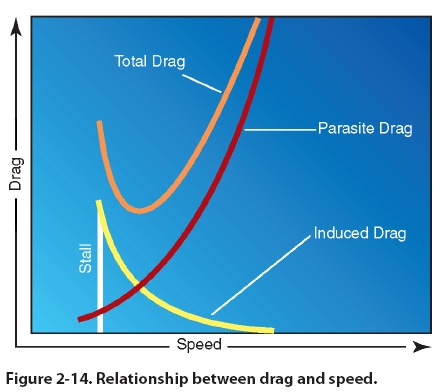Chapter 2 - Aerodynamics of Flight
Drag
Drag is the resistance to forward motion through the
air. Drag opposes thrust. Aerodynamic drag comes in
two forms:
1. Induced drag: a result of the wing producing lift;
2. Parasite drag: resistance to the airflow from
the cart, its occupants, suspension lines from
the wing, interference drag from objects in the
airstream, and skin friction drag of the wing.
Induced drag is the result of lift, and its amount varies
as discussed above for lift. Induced drag creates
organized circular vortices off the wing tips that generally
track down and out from each wingtip. [Figure 2-
12] This is true for all aircraft that use wings including
PPC, weight-shift control and fixed wing aircraft. The
bigger and heavier the aircraft, the greater and more
powerful the wingtip vortices will be. This organized
swirling turbulence is an important factor to understand
for flight safety. Refer to Section 7-3 of the Aeronautical
Information Manual (AIM) or Chapter 12 of the
Pilot’s Handbook of Aeronautical Knowledge (FAA-H-
8083-25) for additional discussion.

Parasite drag is caused by the friction of air moving
over the structure. Just as with lift, parasite drag increases
as the surface area of the aircraft increases
and dramatically increases as airspeed increases,
at the square of the velocity. Therefore, doubling
the airspeed will quadruple your parasite drag.
[Figure 2-13]

The PPC has relatively slow speeds, but plenty of
items (area) for the wind to strike including wing,
lines, pilot, cart, engine, wheels, and tubes. Parasitic
drag can be reduced by streamlining the items but
since the PPC flies at relatively slow airspeeds, the extra weight, cost, and complexity of streamlining the
PPC is generally not incorporated into the design.
Total Drag is the combination of parasite and induced
drag. Total Drag = Parasitic Drag + Induced Drag
To help explain the force of drag, the mathematical
equation D = Cd · q · S is used. In this equation drag
(D) is the product of drag coefficient (Cd), dynamic
pressure (q) determined by the velocity squared times
the air density factor, and surface area (S) of the cart
and the ram-air wing (S). The drag coefficient is the
ratio of drag pressure to dynamic pressure.
Induced and parasitic drag have opposite effects as
angle of attack decreases and speed increases. Note
the total drag. It is high at the slowest air speeds at
high angles of attack near the stall, decreases to the
lowest at the most efficient airspeed, and then progressively
increases as the speed increases. The PPC
wing is typically designed to fly at a speed generally
above lowest overall total drag. Too slow, and the
wing would be near its critical angle of attack. Too
fast, and the power to maintain level flight or climb
would be excessive. The manufacturer determines the
speed range of the wing based on the weight range,
and the resultant location on the total drag diagram.
[Figure 2-14]

|

